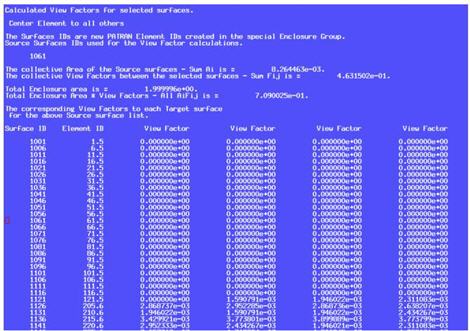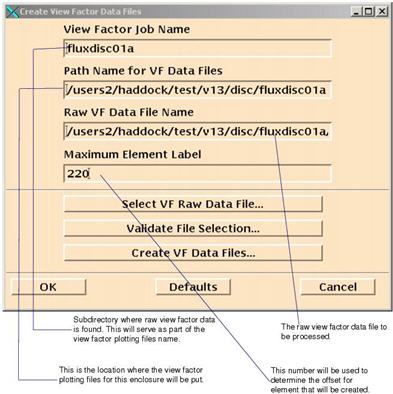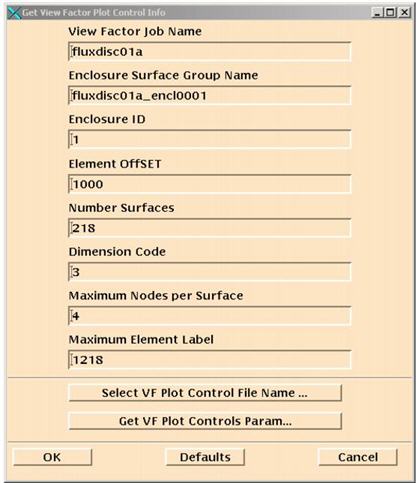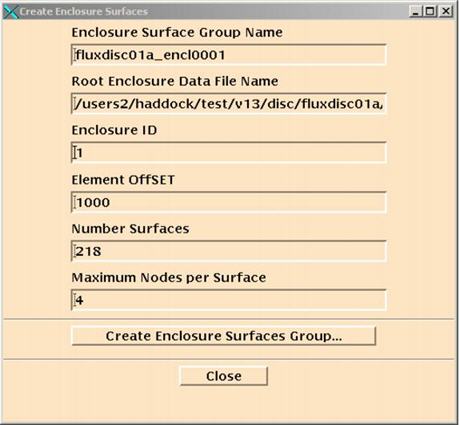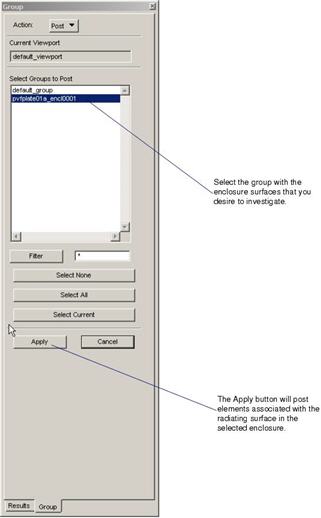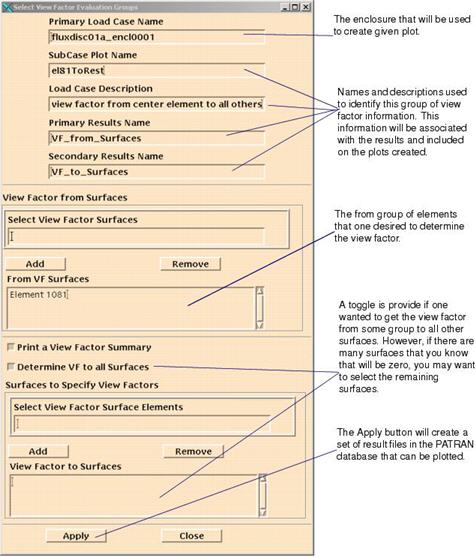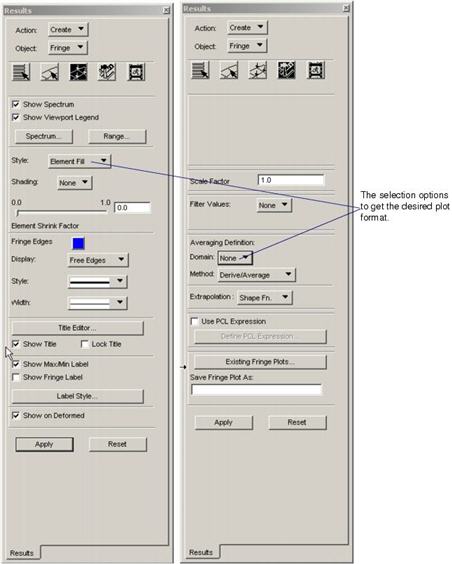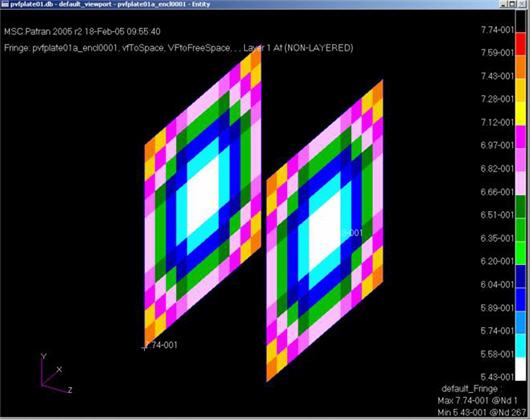XXXXXXXXXXXXXXXXXXXXXXXXXXXXXXXXXXXXXXXXXXXXXXXXXXXXXXXXXXXXXXXXXXXXXXXXXXXXXXXXXXXXXXXXXXXXXXXXXXXXXXXXXXXXXXXXXXXXXXXXXXXXXXXXXXXXXXXXXXXXXXXXXXXXXXXX''"> Plot View Factors
Pthermal creates a binary view factor data file that contains all raw information related to the view factors between each surface in a given enclosure.The view factors are calculated based on the subnodal representation of each element.This data can be extracted and put in text data files that will enable the user to determine relative view factor data between any surface or group of surfaces. The subsequent data then loses the finer view factor information associated with the subnodal area; however, this is only for examination purposes. The radiation network used in the calculations still reflects the subnodal refinement. This operation is not automatic and requires interactive operation by the users. There is a sequence of operations the user needs to follow to create and investigate the calculated view factors. The first time through the user must Create VF Data Files for the desired enclosure. To plot the view factors, groups will be created that have surfaces related to each enclosure with the Create Enclosure Surfaces button. Each time before creating a plot, first select the controls associated with a given enclosure through the Define/Get VF Plot Controls. Only post the group with the desired enclosure information and define the view factor groups with Plot View Factors.
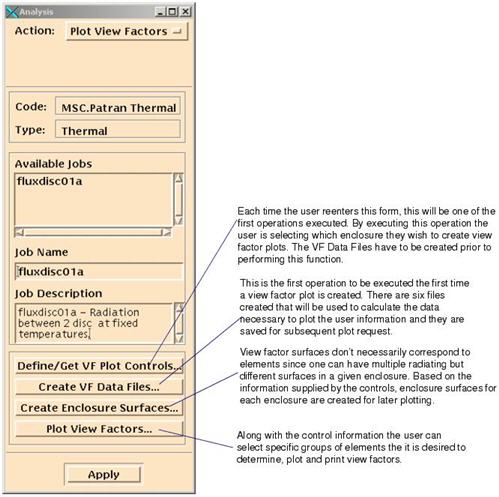
Create VF Data Files
The Pthermal view factor raw data file contains too much information and is not in a form that is convenient to create arbitrary view factor information and plot it. Six text files are created that contains information that the user can examine and is in a form that can easily be used to create view factors for any user selected grouping. These files will have a user defined prefix which is usually the same as the job name directory. Appended to this is the enclosure ID while the final suffix denotes the type of file. All files have data only with no header information. Each file type is defined below.
Control file .cntr
The control file contains a single record with:
1. Enclosure ID
2. Number of Surfaces
3. Dimension Code
4. Surface Offset
5. Maximum Surface ID
6. Maximum Number of Nodes per Surface
This information applies to one enclosure and will become initial values for subsequent enclosures. The dimension code is defined ( p 143 view factor manual ). The surface offset is adjusted such that a surface ID can be easily identified. The maximum surface ID will be used as the seed offset for the next enclosure.
Correspondence File .cors
The correspondence file contains information that relates each surface to element and node data related to the model. For each surface there are two records.
The first record contains:
1. Surface ID
1. Element ID
1. Element Face ID
1. Surface Configuration
1. Number of Nodes
The second record contains:
1. Node ID’s for this surface
Surface Area .area
This file contains the surface area of each surface. Each record contains:
1. Surface ID
1. Surface Area
Residual View Factor .vfsp
The value of each view factor in a closed enclosure should be one. The thermal module uses the view factors as calculated rather than make adjustments to have each one summing to one. It is felt that numerical calculation would over predict as well as under predict so over the whole enclosure numerical error would cancel better than attempting to make each one have exact closure on one. Also, any leaks in an enclosure would let energy escape the enclosure is included as part of the residual. By plotting the residuals one can see the errors or get the view factor to space. The residual file contains:
1. Surface ID
1. One minus the Sum of View Factor - ( 1.0 - Fi )
View Factor Matrix .mtrx
A file is created in which for each surface the product of the surface area and the view factor to every other surface is specified. This is the information that sequentially is used by the user to create plots from one view factor group to another. All information associated with each surface is written as a single record
1. Surface ID(i), ( AiFij for j from surface i to number of surfaces
View Factor .vfij
A file is created in which for each surface the view factor to every other surface is specified. This can be examined to determine the view factor from any surface to any other surface; however, this file is not used in any subsequent view factor calculations. All information associated with each surface is written as a single record
1. Surface ID(i), ( Fij for j from surface i to number of surface
The form to extract these files is shown below. The sequence of operations are to select a raw view factor data file, validate the file selection and then create the view factor data files. If the raw data file selected the validation operation will produce an error message rather than letting one to continue.:
Define/Get VF Plot Controls
Whenever the user is going to create a set of view factor plots they must define the enclosure desired and specify some identifier that will be associated with each set of view factor plots. This is done through the Plot Controls form. Each enclosure has a set of files associated with it for plot creation. This file identifies the enclosure and information necessary to size arrays etc. for the view factor calculations. The desired control file is selected from the Select VF Plot Control File Name and then the needed data is loaded through the Get VF Plot Controls.
Create Enclosure Surfaces
For convenience and so users can isolate different parts of the model, a separate group is defined with a set of surfaces corresponding to each enclosure. This group should be all that is posted when one is plotting various view factors. After one has finished examining the view factors and this information will no longer be needed and can be deleted.
Post Enclosure Group
To simplify looking at radiation surfaces one should only post the surfaces in the enclosure being examined. Using the Group -> Post form select the surface group.
Plot View Factors
The plot view factors form allows the user to group of surfaces in a from-to grouping they desire to obtain view factors between. An option is available to create a file with a summary of the data just plotted.
Plotting the Results
The element results in the database can be plotted through the Results -> Create -> Fringe forms.
1. First select the results case one desires to examine.
2. Determine the type of plot you desire. The view factors are from a selected group to each individual element in the to group. Thus the most meaningful is probably the Element Fill since the calculated view factor is the weighted sum of each subnodal view factor. If discrete contours are desired the element values are evaluated for all elements associated with each node.
3. The Domain should be set to None if the element file is to be used so that the true view factor for each element is plotted. If the contour plots are desired set the Domain to All Entities if the continuous option is used.
The fringe selection forms are shown below.
Following are some examples of view factor plots. The example is two parallel plates one unit on a side and 0.6 units apart. For this case the view factor to space is greater than it is to the other plate for each element.
A plot from a single surface to all other surfaces is shown below in the element file mode. Note that the sum of all view factors is from the single surface to all other surfaces is included in the title.
The same plot is shown below in a discrete/smooth format.
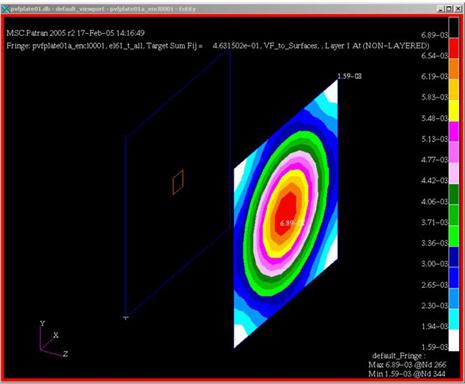
A sample of the output is shown below. The surface list for each group is defined in the output. The total surface area for the from surface and the resulting view factor between the groups is defined. A second set of area and view factor is shown. This is the total surface area of all elements in the enclosure and the sum of all view factor area products in the enclosure. For a totally enclosed system the total sum for area and area view factor product should be one. The individual view factor from the “from group” to each individual surface is output. A partial table is shown below. The Surface ID that is defined by radiating surface with the given offset and its corresponding element ID for the view factor specified in the first column. The next surfaces continues incrementing by one for the next columns on that given row. There is no break on a row if the numbering has gaps. For example surface 1121 begins with element 121.5 (where .5 indicates the top of a surface) begins in the first column. Element 210.6 is shown in the second column, but the element ID is not consistent with the surface ID until the next row. The file below is only representative and does not include all columns or rows.
